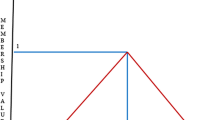Abstract
In the present work, uncertainty-based dynamic sampling frameworks were tested for a sampling horizon with multiple time steps. Future concentration values were assumed as fuzzy numbers. Multiple realization–based simulations were used for generation of fuzzy numbers. The first framework considers fuzzy variance reduction. The second framework considers mass estimation error reduction with maximization of spatial coverage of the dynamic sampling network. It is a multi-objective optimization problem with a large number of objectives. In Dhar and Patil (2012), uncertainty-based optimal sampling design model was suggested using Nondominated Sorting Genetic Algorithm-II (NSGA-II) as its optimization algorithm. However, NSGA-II becomes computationally expensive while handling more than three objectives. We extend the previously suggested algorithm for multi-objective sampling network design problems based on NSGA-III framework. Two design frameworks were proposed: one incorporating a simulation model and a fuzzy covariance for minimizing the total contaminant-concentration variance and the other incorporating a simulation model and a fuzzy kriging model in conjunction with an optimization model to minimize the fuzzy mass estimation error and spatial coverage of spatiotemporal sampling locations. NSGA-III was used for solving the sampling network design model. Performances of the proposed frameworks were evaluated for two hypothetical illustrative examples. The results indicate that the proposed design frameworks perform satisfactorily under uncertain system conditions.












Similar content being viewed by others
References
Ababou, R. (1988). Three-dimensional flow in random porous media. Ph.D. Thesis, Massachusetts Institute of Technology, Cambridge, Massachusetts. http://hdl.handle.net/1721.1/14675. Accessed Jan 2018.
Afshar, A., Maririo, M., Ebtehaj, M., & Moosavi, J. (2007). Rule-based fuzzy system for assessing groundwater vulnerability. Journal of Environmental Engineering, 133(5), 532–540.
American Society of Civil Engineers Task Committee on Long-Term Groundwater Monitoring Design. (2003). Long-term groundwater monitoring: the state of the art, Reston, VA.
Chadalavada, S., & Datta, B. (2008). Dynamic optimal monitoring network design for the transient transport of pollutants in groundwater aquifers. Water Resources Management, 22(6), 651–670.
Chadalavada, S., Datta, B., & Naidu, R. (2011). Uncertainty based optimal monitoring network design for chlorinated hydrocarbon contaminated site. Environmental Monitoring Assessment, 173(1–4), 929–940.
Datta, B., & Singh, D. (2014). Optimal groundwater monitoring network design for pollution plume estimation with active sources. International Journal of Geomate, 6(2), 864–869.
Deb, K., & Jain, H. (2014). An evolutionary many-objective optimization algorithm using reference-point-based nondominated sorting approach, part I: solving problems with box constraints. IEEE Transactions on Evolutionary Computation, 18(4), 577–601.
Deutsch, C. V., & Journel, A. G. (1998). GSLIB: geostatistical software library and user’s guide. New York: Oxford University Press.
Dhar, A., & Datta, B. (2007). Multiobjective design of dynamic monitoring networks for detection of groundwater pollution. Journal of Water Resources Planning and Management, 133(4), 329–338.
Dhar, A., & Datta, B. (2009). Global optimal design of ground water monitoring network using embedded kriging. Ground Water, 47(6), 806–815.
Dhar, A., & Datta, B. (2010). Logic-based design of groundwater monitoring network for redundancy reduction. Journal of Water Resources Planning and Management, 136(1), 88–94.
Dhar, A., & Patil, R. (2012). Multiobjective design of groundwater monitoring networks under epistemic uncertainty. Water Resources Management, 26(7), 1809–1825.
Diamond, P. (1989). Fuzzy kriging. Fuzzy Sets and Systems, 33(3), 315–332.
Feng, Y., Hu, L., & Shu, H. (2001). The variance and covariance of fuzzy random variables and their applications. Fuzzy Sets and Systems, 120(3), 487–497.
Harbaugh, A. W., Banta, E. R., Hill, M. C., & McDonald, M. G. (2000). MODFLOW-2000, the US geological survey modular ground-water model-user guide to modularization concepts and the ground-water flow process.US Geological Survey Open-File Report 00-92.
Herrera, G. S., & Pinder, G. F. (2005). Space-time optimization of groundwater quality sampling networks. Water Resources Research, 41(12).
Kollat, J. B., Reed, P. M., & Kasprzyk, J. R. (2008). A new epsilon-dominance hierarchical bayesian optimization algorithm for large multi-objective monitoring network design problems. Advances in Water Resources, 31(5), 828–845.
Kollat, J. B., Reed, P. M., & Maxwel, R. M. (2011). Many-objective groundwater monitoring network design using bias-aware ensemble Kalman filtering, evolutionary optimization, and visual analytics. Water Resources Research, 47(2).
Loaiciga, H. A., Charbeneau, R. J., Everett, L. G., Fogg, G. E., Hobbs, B. F., & Rouhani, S. (1992). Review of ground-water quality monitoring network design. Journal of Hydraulic Engineering, 118(1), 11–37.
McDonald, M. G., & Harbaugh, A. W. (1988). A modular three-dimensional finite-difference ground-water flow model. USGS Techniques of Water-Resources Investigations, Book 6, Chapter A1.
Muhammetoglu, A., & Yardimci, A. (2006). A fuzzy logic approach to asses groundwater pollution levels below agricultural fields. Environmental Monitoring and Assessment., 118(1–3), 337–354.
Prakash, O., & Datta, B. (2013). Sequential optimal monitoring network design and iterative spatial estimation of pollutant concentration for identification of unknown groundwater pollution source locations. Environmental Monitoring and Assessement, 185(7), 5611–5626.
Prakash, O., & Datta, B. (2014a). Multiobjective monitoring network design for efficient identification of unknown groundwater pollution sources incorporating genetic programming based monitoring. Journal of Hydrologic Engineering, 19(11), 04014025.
Prakash, O., & Datta, B. (2014b). Optimal monitoring network design for efficient identification of unknown groundwater pollution sources. International Journal of Geomate, 6(1), 785–790.
Qin, X. S., Huang, G. H., & Chen, B. (2006). Environmental risk assessment for groundwater contamination through integrated fuzzy techniques. Environmental Informatics Archives, 4, 82–87.
Reed, P., & Minsker, B. S. (2004). Striking the balance: long-term groundwater monitoring design for conflicting objectives. Journal of Water Resources Planning and Management, 130(2), 140–149.
Zheng, C., & Wang, P. P. (1999). MT3DMS: a modular three-dimensional multi-species transport model for simulation of advection, dispersion and chemical reactions of contaminants in groundwater systems; documentation and user's guide. U.S. AERDCC Report SERDP-99-1, Vicksburg, MS.
Author information
Authors and Affiliations
Corresponding author
Additional information
Publisher’s note
Springer Nature remains neutral with regard to jurisdictional claims in published maps and institutional affiliations.
Rights and permissions
About this article
Cite this article
Kumari, K., Jain, S. & Dhar, A. Computationally efficient approach for identification of fuzzy dynamic groundwater sampling network. Environ Monit Assess 191, 310 (2019). https://doi.org/10.1007/s10661-019-7467-3
Received:
Accepted:
Published:
DOI: https://doi.org/10.1007/s10661-019-7467-3




